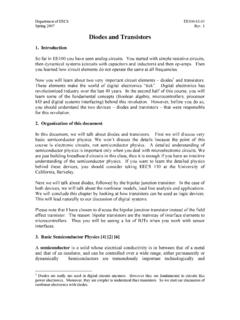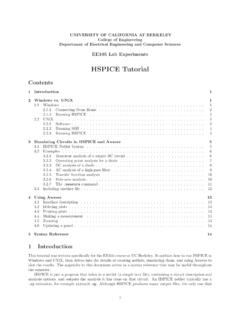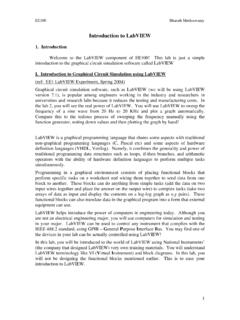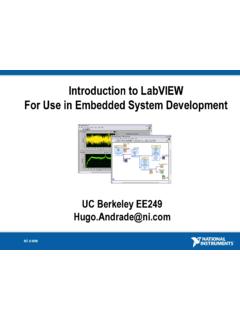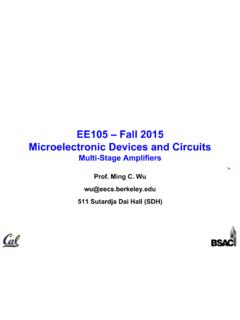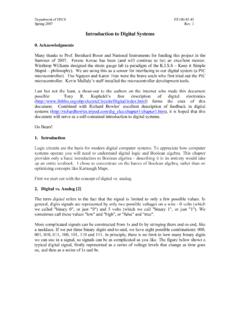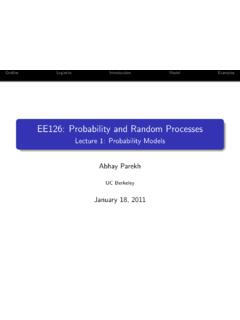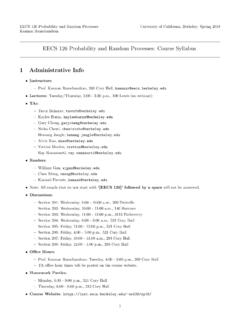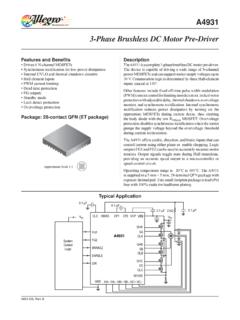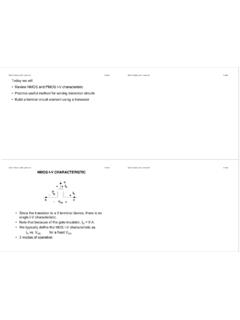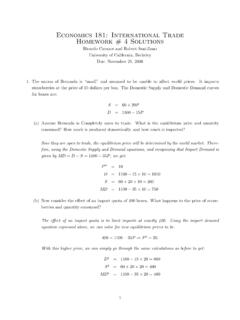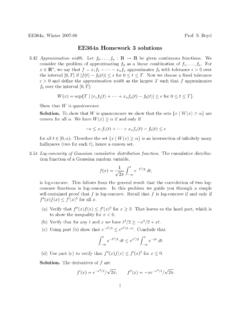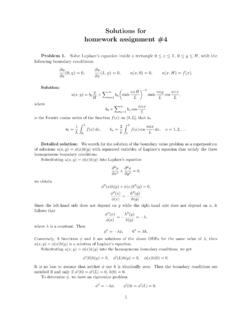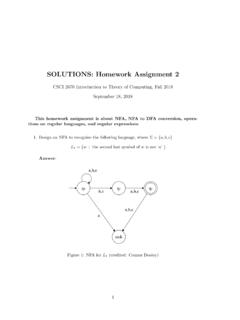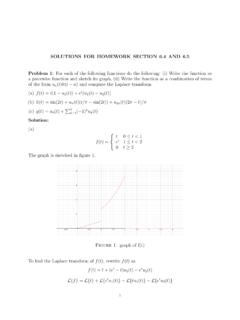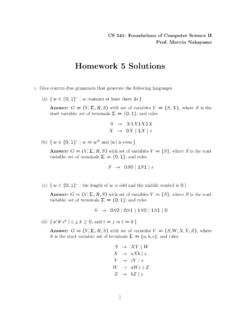Transcription of Homework 6 - Solutions - University of California, Berkeley
1 EE C128 / ME C134 Spring 2014 HW6 - Solutions UC Berkeley Homework 6 - Solutions Note: This Homework is worth a total of 45 points. 1. Steady State Error Analysis of a unity feedback system (5 points). For the unity feedback system shown below, where 5000. G(s) =. s(s + 75). (a) What is the expected percent overshoot for a unit step input? (b) What is the settling time for a unit step input? (c) What is the steady-state error for an input of 5u(t)? (d) What is the steady-state error for an input of 5tu(t)? (e) What is the steady-state error for an input of 5t2 u(t)? Solution: The closed-loop transfer function is given by: 5000. T (s) =. s2 + 75s + 5000.. (a) From T (s), we can check that n = 5000 and 2 n = 75. Thus, = and %OS is given by, . 2. %OS = e / 1 100 = 4. (b) Ts = = sec. n (c) Error is given by: R(s)C(s). E(s) = R(s) C(s) = R(s) = R(s)(1 T (s)). R(s).. 5000. E(s) = R(s) 1 . s2 + 75s + 5000.
2 Now, . 5 5000. ess = e( ) = lim sE(s) = s 1 2 =0. s 0 s s + 75s + 5000. (d) Using E(s) from above, the steady state error for a ramp input is given by: . 5 5000. ess = e( ) = lim sE(s) = s 2 1 2 = s 0 s s + 75s + 5000. Rev. , 03/08/2014 1 of 9. EE C128 / ME C134 Spring 2014 HW6 - Solutions UC Berkeley (e) Using E(s) from above, the steady state error for a parabolic input is given by: . 5 5000. ess = e( ) = lim sE(s) = s 3 1 2 = . s 0 s s + 75s + 5000. 2. Steady State Error Analysis of a unity feedback system (3 points). Consider the unity feedback system shown in Problem 1. If G(s) is given as follows, find the value of to yield a Kv = 25000. 100500(s + 5)(s + 14)(s + 23). G(s) =. s(s + 27)(s + )(s + 33). Solution: We know that Kv = lims 0 sG(s), where G(s) is the open-loop transfer function. Thus, 100500(s + 5)(s + 14)(s + 23) 100500(5)(14)(23). Kv = lim sG(s) = lim s = = 25000. s 0 s 0 s(s + 27)(s + )(s + 33) 27( )(33).
3 = 3. Steady State Error Analysis (5 points). For the system shown below, (a) Find Kp , Kv and Ka . (b) Find the steady-state error for an input of 50u(t), 50tu(t) and 50t2 u(t). (c) State the system type. Solution: Let Ge (s) be the equivalent open-loop transfer function, then 5. s(s + 1)(s + 2) 5. Ge (s) = = 3 2. 5(s + 3) s + 3s + 7s + 15. 1+. s(s + 1)(s + 2). (a) Now, Kp , Kv and Ka can be calculated as follows Kp = lim Ge (s) = s 0. Kv = lim sGe (s) = 0. s 0. Ka = lim s2 Ge (s) = 0. s 0. Rev. , 03/08/2014 2 of 9. EE C128 / ME C134 Spring 2014 HW6 - Solutions UC Berkeley (b) Using the values of Kp , Kv and Ka , we can find the steady-state errors as follows 50. For r(t) = 50u(t), ess = e( ) = = 1 + Kp 50. For r(t) = 50tu(t), ess = e( ) = = . Kv 50. For r(t) = 50t2 u(t), ess = e( ) = = . Ka (c) Since there are no pure integrations in the open-loop transfer function, the system is Type 0.
4 4. Steady State Error Analysis (5 points). Given the system shown below, find the following (a) The closed-loop transfer function (b) The system type (c) The steady-state error for an input of 5u(t). (d) The steady-state error for an input of 5tu(t). (e) Discuss the validity of your answers to Parts c and d. Solutions : (a) For the inner loop: 1. s2 (s + 1) s G1 (s) = = 4. 1 s + s3 + 1. 1+ 3. s (s + 1). The equivalent open-loop transfer function Ge (s) is then given by 1 1. Ge (s) = G1 (s) =. s2 (s+ 3) s(s + 4s + 3s3 + s + 3). 5 4. Ge (s) 1. T (s) = = 6. 1 + Ge (s) s + 4s + 3s + s2 + 3s + 1. 5 4. (b) From inspection of Ge (s), we can say that Kp = , Kv = constant and Ka = 0. Thus the system is Type 1. (c) Since the system is type 1, for r(t) = 5u(t), ess = e( ) = 0. (d) From Ge (s), Kv = lims 0 sGe (s) = 1/3. Therefore, ess = 5/Kv = 15. (e) Poles of closed-loop transfer function T (s) : , , , Since we have a Rev.
5 , 03/08/2014 3 of 9. EE C128 / ME C134 Spring 2014 HW6 - Solutions UC Berkeley pair of complex poles in the RHP, the closed-loop system is unstable. Thus, our Solutions for parts (c) and (d) are meaningless. 5. Steady State Error Analysis (10 points). For each of the systems shown below, find the following (a) The system type (b) The appropriate static error constant (c) The input waveform to yield a constant error (d) The steady-state error for a unit input of the waveform found in Part c (e) The steady-state value of the actuating signal. Solutions : System 1. Let G(s) be the feedforward transfer function and H(s) be the feedback transfer function. Then, the equivalent open-loop transfer function with unity feedback loop, Ge (s) is given by: G(s) 10(s + 10). Ge (s) = = 2. 1 + G(s)H(s) G(s) 11s + 132s + 300. (a) Since there are no pure integrators in Ge (s), the system is Type 0. (b) Kp in type 0 systems is constant.
6 Kp = lim Ge (s) = s 0. (c) Type 0 systems require a step input for a constant error. Rev. , 03/08/2014 4 of 9. EE C128 / ME C134 Spring 2014 HW6 - Solutions UC Berkeley 1. (d) For r(t) = u(t), ess = e( ) = = 1 + Kp (e) Let ea (t) be the actuation signal. Then, sR(s) 1. ea ( ) = lim = lim =0. s 0 1 + G(s)H(s) s 0 10(s + 10)(s + 4). 1+. s(s + 2). System 2. Let G(s) be the feedforward transfer function and H(s) be the feedback transfer function. Then, the equivalent open-loop transfer function with unity feedback loop, Ge (s) is given by: G(s) 10(s + 10). Ge (s) = =. 1 + G(s)H(s) G(s) s(11s + 102). (a) Since there is one pure integrator in Ge (s), the system is Type 1. (b) Kv in type 1 systems is constant. Kv = lim sGe (s) = s 0. (c) Type 0 systems require a ramp input for a constant error. 1. (d) For r(t) = tu(t), ess = e( ) = = Kv (e) Let ea (t) be the actuation signal. Then, 1. sR(s) s 1.
7 Ea ( ) = lim = lim s2 =. s 0 1 + G(s)H(s) s 0 10(s + 10)(s + 1) 50. 1+. s(s + 2). 6. Sensitivity Of Steady State Error (3 points). For the system shown below, find the sensitivity of the steady-state error for changes in K1 and in K2 , when K1 = 100 and K2 = Assume step inputs for both the input and the disturbance. Rev. , 03/08/2014 5 of 9. EE C128 / ME C134 Spring 2014 HW6 - Solutions UC Berkeley Solutions : Using Equation ( ) from the textbook, we can write the steady-state error as follows: K1 K2 K2. s + 2 s +2 2 K2. e( ) = 1 lim lim =. s 0 K1 K2 (s + 1) s 0 K1 K2 (s + 1) 2 + K1 K2. 1+ 1+. s+2 s+2. Sensitivity to K1 : K1 e K1 K2 (100)( ). Se:K1 = = = = e K1 2 + K1 K2 2 + (100)( ). Sensitivity to K2 : K2 e 2K2 (1 + K1 ) 2( )(1 + 100). Se:K2 = = = = e K2 (K2 2)(2 + K1 K2 ) ( 2)(2 + 10). 7. Root Loci Inspection (8 points). For each of the root loci shown below, tell whether or not the sketch can be a root locus.
8 If the sketch cannot be a root locus, explain why. Give all reasons. Solutions : (a) No. Root Locus is always symmetric about the real axis. (b) No. Root Locus is always to the left of an odd number of poles or zeros on the real axis. (c) No. Root Locus is always to the left of an odd number of poles or zeros on the real axis. (d) Yes. (e) No. Root Locus is always symmetric about the real axis. Root Locus is always to the left of an odd number of poles or zeros on the real axis. (f) Yes. Rev. , 03/08/2014 6 of 9. EE C128 / ME C134 Spring 2014 HW6 - Solutions UC Berkeley (g) No. Root Locus is always symmetric about the real axis. (h) Yes. 8. Sketching Root Loci (6 points). Sketch the general shape of the root locus for each of the open-loop pole-zero plots shown below. Please print out this page and attach it with your Solutions to other problems. Rev. , 03/08/2014 7 of 9. EE C128 / ME C134 Spring 2014 HW6 - Solutions UC Berkeley Solutions : Rev.
9 , 03/08/2014 8 of 9. EE C128 / ME C134 Spring 2014 HW6 - Solutions UC Berkeley Rev. , 03/08/2014 9 of 9.
